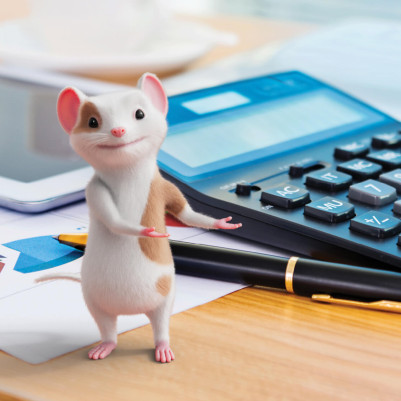
Getting a deposit together takes careful planning, saving and investing.
But your deposit isn’t the only cost of buying a home: there’s also the mortgage, insurance, legal fees and more. Let’s break it down into steps.

Keep in mind that the bigger your deposit, the less you’ll pay in interest on your mortgage.
Your deposit is just one of the upfront costs that comes with buying your first home. You’ll need to plan for lawyer’s fees, a builder’s report, Land Information Memorandum (LIM), and the costs that come with moving in.
Lawyer's fee
Before signing any sale agreement or mortgage paperwork, you’ll need to get it looked over by a lawyer. They also handle the ‘conveyancing’ or transfer to you once you buy a house. Fees vary, so shop around.
Find a lawyer and information about the legal issues involved in buying a home on the Property Law website.
Builder's report
A builder’s report can identify any possible problems with the house you’re looking at buying. An experienced builder will find things that the untrained eye will miss and may save you thousands.
LIM
A Land Information Memorandum (LIM) identifies any issues with the land the house is built on, such as drainage and landslip risks. Order a LIM through the local council, or your lawyer can do it for you.
Moving-in costs
You’ll need to set money aside for things like:
Mortgage repayments aren’t the only thing you’ll need to budget for in your new life as a homeowner. Make sure to include insurance, rates and other ongoing costs in the calculations.
House, contents and mortgage insurance
Your home will be your biggest commitment when you have a mortgage and your biggest asset once it is paid off, so you’ll need to protect it from the unexpected.
As well as house and contents insurance, you may need to look at life insurance and mortgage repayment insurance. Remember that lender’s mortgage insurance doesn’t cover you, it covers the bank if you can’t repay your loan.
Find out more about different types of insurance to consider for a new home.
Rates
When you buy your first home you become a ratepayer. Rates are charges set by local councils to provide and maintain things like roads, water supply, sewerage, parks, pools and libraries. They can be up to thousands of dollars a year.
Ask the real estate agent what a property’s rates are before making an offer – so you know if you can afford them. You may also be able to search for a property’s rates on the local council website.
Body corporate fees
If you’re buying an apartment or townhouse that’s part of an accommodation complex and has ‘unit title’, you’ll probably need to pay body corporate fees. These cover things like insurance and maintenance of shared areas. Is there a fund for major maintenance work in place? Get a lawyer to go over these details carefully.
Once you have nearly got your deposit together the next step is to get ‘preapproval’. You can do this before you have found a property, to make the buying process faster and easier. You can then house hunt knowing what you can (and can’t) afford from day one.
You’ll need to show your lender or mortgage broker these documents:
Your lender or mortgage broker will then assess your situation as well as other details. They’ll let you know whether you’ve been preapproved and a specific loan amount you can expect to borrow.
There are guides available that can help you find a good deal on your mortgage, and learn about the various types of mortgages out there so you can make informed choices as you go.
For more on what to look out for when choosing a property, visit settled.govt.nz.


When you are saving up a deposit for a property, having a plan helps. Our budget planner can help you put yours in place and make sure it’s optimised to get to your goal.
Ideally you would have 20% of the house’s purchase price to put down as a deposit, which means that unless you are buying a million-dollar property, you will probably need less. There are ways of borrowing for a home with even less – for as little as just 5%, although this is typically a more expensive option that brings more risk to both borrower and lender. But it can be done. Here’s more on how much you can borrow.
Generally you can expect a lender to lend up to 80% of the value or price of a house (typically whichever is lower). Often, lower percentages are loaned on properties outside urban areas and on apartments. It is possible to borrow 90% or even up to 95% of a property’s value in some cases. But that’s a big risk for both the borrower and the lender. This means basically that it is best to have a deposit of 20% of the purchase price. Here’s more on how much you can borrow, as well as our mortgage calculator to run your figures.
When buying your first home you may be able to make a one-off withdrawal of most of your KiwiSaver – as long as you’ve been a member for at least three years. You may even qualify if you have owned property previously. Our KiwiSaver calculator can help you find out how much you’re on track to save for your first home.
You can indeed, and even use all of your different KiwiSaver accounts together. Here is one story of two families who did just that.
You’ll want to work with a lender or mortgage broker to get preapproval for a specific loan amount that you can expect to borrow. Having this makes the buying process faster and easier, as you know what you can (and can’t) afford from day one.
You may also need to look into a ‘bridging loan’, which acts as a bridge between buying a new home and selling your existing one. It’s a temporary way of paying for your new house while your existing one sits for sale. Here’s more on bridging finance.
One of the most important things that mortgage lenders look at is how much income you have free in order to make loan repayments. With too much debt, a lot of your income is already committed to other loans, and there’s only so much to go around. Even if you’re not using all of your credit limit, it’s important to know that the lender will assess you as if you are. They will also look at your credit history, and how well you’ve repaid other loans. In the end the lender may decide to lend you less, or nothing at all. Here’s more on how much of a mortgage you could get when buying a home.
Because your student loan repayments are 12% of every dollar you earn above $20,020, that obviously affects how much money you have available to repay a mortgage. Having a student loan makes a mortgage less affordable and can affect mortgage applications. Here are other criteria that affect your ability to borrow.
If you’re feeling left out because you haven’t bought your home, or buying a property seems out of reach, there are ways to invest in property without buying one. For example, there are managed funds, exchange-traded funds (ETFs) and real estate investment trusts (REITs), which are pools of investor money that share in the profits from property. There are advantages to these, including the ability to get your money back quickly.
Use verification code from your authenticator app. How to use authenticator apps.
Don't have an account? Sign up
Or log in with our social media platforms


A free account gives you your very own space where you can save your tools and track your progress as you get ahead.
Or sign up using Google:

